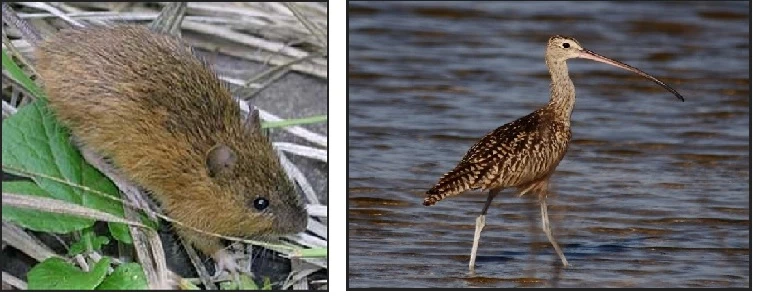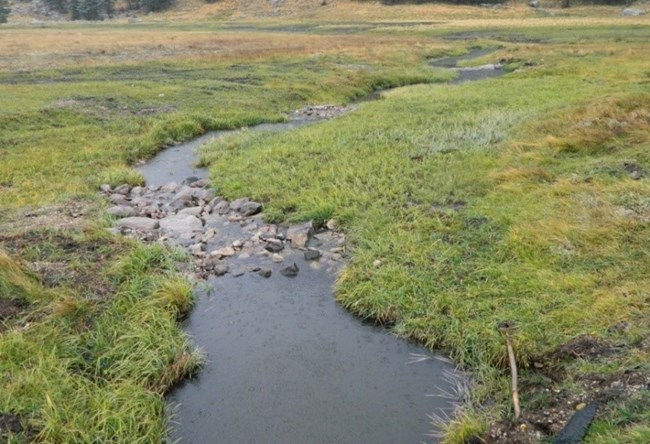Part of a series of articles titled NRCA 2022: Condition of Valles Caldera’s Natural Resources and Scenic Views.
Article
Restoring Wetlands at Valles Caldera

Wetlands were more common in the park historically, but land use practices of the 1800s and 1900s, including livestock overgrazing, road construction, and clear-cut logging, led to their degradation and loss. Post-fire erosion from fires in 2011 and 2013 has also impacted the preserve’s wetlands.
How do you restore a wetland? It’s more complicated than just adding water, but water’s a big part of restoring the health of wetlands at Valles Caldera National Preserve.
Wetland restoration activities in the preserve
Starting in 2011, restoration activities have been undertaken by wetland restoration experts in approximately ten areas, including along La Jara Creek, Jaramillo Creek, Redondo Creek, Valle Seco (which drains into Sulphur Creek), East Fork Jemez River, and in the San Antonio Creek drainage.

NPS/Scott Compton
A project in the Sulphur Creek watershed of the park, for example, focused on using restoration techniques to slow the flow of water, spread out the water, raise the water table to re-hydrate historic wetlands, and increase water storage in the wetlands.
How are the restoration efforts working so far? Previous reports indicate that efforts since 2011 have improved wetland quality and extent in the preserve, and that decreased livestock numbers are also contributing to wetland recovery. However, read on for more recent information!
Assessing conditions of wetlands and restoration efforts at Valles Caldera
A recent Natural Resource Condition Assessment (NRCA) through the NPS NRCA Program focused on seven resources in the park, including wetlands. NRCAs evaluate natural resource conditions so that parks can use the best available science to manage their resources. To assess wetlands, ecologists at Utah State University used restoration data to assess two indicators of wetland health—flow duration (water presence) and cover of wetland plants.
- Flow duration directly affects wetland plant cover. Ecologists used data collected from the field for one summer season before restoration and one summer season after restoration. They evaluated data for three restoration areas.
- Plant cover data (% cover) before and after restoration efforts were also evaluated for a subset of the park’s wetlands (along two creeks and tributaries of a third creek).
What did we learn?
-
Flow duration, or presence of water, increased significantly after restoration activities for the three sites. However, current drought conditions and effects due to climate change make short-term monitoring challenging. Park scientists continue to monitor weather conditions, water quality, and flow conditions related to these projects.
-
Percent cover of wetland plants increased after restoration activities in the three sites evaluated. This indicates the condition for wetland cover is good with an improving trend.
-
Mapping of wetlands prior to and after restoration activities indicated a gain in wetland acreage. Restoration experts note that achieving the full wetland extent may take three to five years post-treatment, so even more gains may be observed with time!
-
Efforts to plant narrowleaf cottonwood (Populus angustifolia) and willows along some creeks have had mixed success. Willows have become well established in some areas, but plantings are struggling in other areas. Structures to exclude ungulates (such as elk) have been used to help prevent them from damaging woody riparian plants.
What can park managers do with this information?
-
The results of this study can be used to assist with park planning and management actions that involve wetlands in the preserve and the species that depend on them, like the New Mexico meadow jumping mouse. The report included discussion of areas for future restoration, but also recommended that wetland experts already conducting restoration be consulted.
-
One result is particularly clear: additional monitoring information collected after restoration activities will be vital in assessing continued results of wetland restoration in the preserve.
- Although ecologists at Utah State University assessed two indicators of wetland health and addressed other park management needs, some questions remain. Future work should try to answer remaining questions, such as:
- How many elk can the preserve sustain with minimal damage to wetlands and restoration efforts? This question should also consider related factors that play a role, such as wetland hydrology and soils and elk behavior and distribution.
Information in this article was summarized from Albright J and Others. 2022. Natural resource conditions at Valles Caldera National Preserve: Findings & management considerations for selected resources. Natural Resource Report. NPS/VALL/NRR—2022/2409. National Park Service. Fort Collins, Colorado. https://doi.org/10.36967/nrr-2293731
Read More about the 2022 Valles Caldera NRCA Project >
Visit the NRCA Program Home>
Last updated: January 12, 2023
